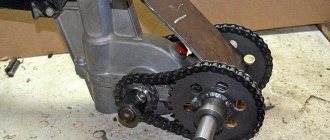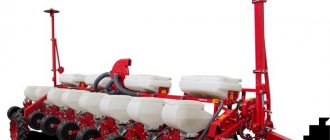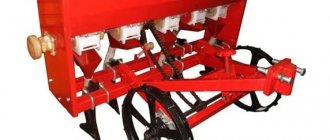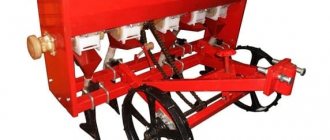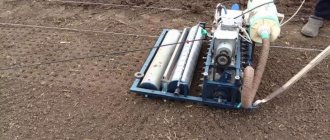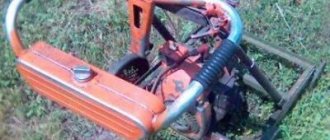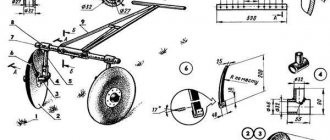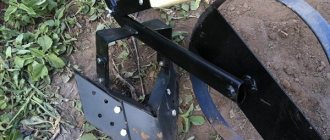Using different planting methods allows you to get a good harvest. The problem of sowing crops with small seeds is solved by using a manual seeder. Models on sale range from simple attachments to trailed devices for a walk-behind tractor or cultivator. When choosing, they are guided by the number of containers, additional accessories, adjustment parameters, and weight.
Advantages
A manual seeder for small seeds with your own hands allows you to save money and simplifies planting crops. Its characteristics are not very different from cheap purchased devices.
Positive aspects of self-production:
- from scrap materials,
- cheap.
Flaws:
- seeds of only one diameter (one crop),
- single row planting.
Note! Several seeders with different hole diameters practically automate seeding. A universal device is more difficult to make; manufacturing will require skill in working with metal and plastic.
Constructions
All models introduce seedlings into the ground; they differ in the method of sowing. Spreaders and planting equipment are provided.
Operating principle of spreaders
There are two types of spreaders:
- Manual: seeds pour out through the holes when you turn the handle of the device; there is a built-in distributor inside. The ability to adjust the diameter of the holes allows us to classify the devices as universal. Usually made of plastic. They are used for spreading fertilizers, but mainly as a manual lawn seeder.
- Mechanical: there is no motor, but there is a moving part. Seeds fall into the ground by periodically pressing a button on the handle while moving. One or more containers for seedlings are attached to the axis.
The main disadvantage of spreaders is the unevenness of sowing, so they are rarely used for vegetables, more often as a disperser for lawn grass.
Precision Fitting Devices
To uniformly sow vegetables, precision sowing devices are used, created on the principle of transmitting torque from the wheel to the shaft:
- Simple: the device moves, the shaft with recesses rotates, the seed from the cone-hopper falls on it, lingers in the recess, and then falls into the prepared groove with a given step. The seeding density depends on the distance between the recesses.
- Complex: the principle of operation is the same, but additional devices are added. Blades or spikes are attached to the front wheel to create grooves during movement, while the rear wheel is made level, which allows you to level the ground after landing. The supply of seeds to the shaft is regulated by a valve, and the seedlings move from the hopper along a special spout .
They are suitable for crops with small seeds, just like a seeder for regular lawn grass.
Note! The device allows you to work in a comfortable position, increases the sowing speed, and the seeds are distributed evenly.
Recycled materials, jars or plastic bottles will be useful when making a simple version of the product, and iron sheets, wheels, etc. will be needed for complex designs.
Rules of application
It is recommended to sow the lawn in dry soil in calm weather. Before you start sowing, you need to loosen it with a fan or regular rake and level it. The surface soil layer must be compacted with a roller or roller.
The operating principle of the hand-held device is very simple and looks like this:
- Pour the seeds into the hopper.
- Operate the seeder using pushing movements while simultaneously rotating the handle.
For maximum uniform seeding, you can use the cross method. To do this, the number of seeds must be divided in half: one half should be sown lengthwise, and the other half crosswise.
Important! To prevent the crops from being dense and the seeder from clogging, you should not immediately pour a large number of seeds into the box. It's better to add them gradually.
The principle of operation of mechanical devices is the same as that of manual ones. But you don’t need to turn the handle in them. The diffuser is activated by pressing a button. Adjustment of the dispenser occurs without much effort. Professional machines are controlled using levers and buttons. After the seeds are scattered over the area, the ground must be leveled with a rake, covering them with a layer of 5 mm. It is also recommended to carry out compaction.
So, you can get the perfect lawn at your dacha if you sow it using a seeder. For small areas, hand-held devices are suitable, which you can buy or make yourself from improvised means. If you have to cover a large area with a grassy carpet, then it is better to purchase a mechanical unit.
Devices for planting carrots
In country garden beds, carrots occupy a small area, so for planting it is enough to use improvised means.
Manual planters
An easy way to spread seeds evenly in the garden is to use common household items to help plant the seeds at some distance from each other. Manual carrot planter includes:
- medicine box with dispenser - sowing is done by squeezing,
- medical syringe - push version,
- old salt or pepper shaker - the holes are widened for planting.
It’s useful to know, read: — Choosing a manual seeder for small-seeded crops.
A do-it-yourself carrot planter can be made from different materials:
- from a plastic bottle: you can drill or punch a hole in the cap using a nail or screwdriver. For sowing, a tube is inserted and the seeds are mixed with sand. If you cook a paste from flour or jelly from starch, and then add seedlings to it, then the tube will not be needed;
- from a block: screw or nail bottle caps to the board at a distance of 1.5–2 cm. They squeeze out holes in the garden bed, fill them with seeds, water them and cover them with soil. If the lids are replaced with wooden pins 5 cm long, you will get a manual garlic planter;
- from a wooden rake: the teeth are fixed perpendicular to the ground, they are used to make holes in a loosened bed, and plant a vegetable.
Seeders for garden beds
A more convenient way of planting is to make simple devices. A do-it-yourself carrot seeder includes a roller and consists of a round body, an axis of rotation and a handle-handle. In the body, the central hole provides the ability to rotate around an axis, and the diameter of the holes is for planting crops. The handle sets the roller in motion, the body rotates, and the seeds fall out.
Note! When using a homemade roller, you do not need to bend towards the ground. The height of the handle is adjusted to the height of the person. Allows you to plant other crops with small seeds.
A manual carrot seeder, made with your own hands: metal tubes that are bent at an angle depending on the height of a person are suitable for the work; the container for grains is made in the form of a cone or funnel from a sheet of iron. A hopper (one or several) with the top down, wheels and handles are attached to a metal axle.
Kinds
Mechanical seeders are divided, in turn, into rotary and precision seeders.
A rotary seeder scatters seeds over a specified distance. At the same time, it works faster, but scatters randomly. The result may not please you.
With such sowing, the lawn may become overgrown unevenly, and you will again have to deal with bald spots on it.
A precision seeder is a mechanism for creating a perfect, even lawn. It is equipped with a coulter that makes furrows to a given depth. Seeds are fed from above and evenly placed in the furrows.
Have you decided to buy a seeder, and are you faced with the question of choosing a manufacturer? First of all, you should focus on your needs - the size of the plot, the range of functions and ease of operation of the mechanical seeder.
One of the main manufacturers whose products are in constant demand is GARDENA.
The price-quality ratio is the main advantage of this product.
GARDENA Classic 300
If you do not need a complex machine, pay attention to the brand of spreader-seeder GARDENA Classic 300. Its technical characteristics:
- spreading width – 45 cm;
- Hopper volume – 10 liters;
- ability to load different sizes of material;
GARDENA Classic 300
- locking the spread when moving backwards (allows you to control the planting volume);
- the presence of a special table for dosing seeds or fertilizers;
- elastic spreading cylinder ensuring uniform distribution of seed;
- two-wheel drive;
- Convenient control via T-handle:
- durable, corrosion-resistant hopper material;
- "tractor" wheel profile.
The seeder is small in size and is recommended for lawns of about 300 square meters. m. It can be used at any time of the year, it is convenient to store. Estimated cost – 3000 rubles.
GARDENA Comfort 500
This model is equipped in the same way as the previous one. It differs from it in a more capacious hopper - 14 liters - and a spreading width of 53 cm. The seeder is designed for sowing an area of up to 500 square meters. m. Cost about 4000 rubles.
GARDENA Comfort 500
Both models are convenient for applying fertilizer. A special measuring table allows you to very accurately set the dosage per 1 square meter of area.
Let's make a seeder from a plastic bottle
This seeder is inexpensive and simple.
Prepare a used plastic bottle and tool. A suitable bottle will be the one that suits you in volume: 0.5 liters, 1 or 2 liters.
Holes in the bottom of a plastic bottle can be drilled or pierced with a hot nail. To avoid getting burned, hold the nail with pliers over a fire or heating device. Holes must be made all over the bottom: first, a little and check by pouring the seeds, shake over the pan, if this is not enough, do more.
See the diagram for hole diameter:
Do-it-yourself precision fit device
The model is made according to a drawing prepared in advance. A simple version is made from a plastic or metal round jar with holes in diameter, their size is for the seeds of the planted crop, a pusher handle and an axis of rotation.
Another option is an axle with attached two wheels, a shaft, a grain hopper and a pusher handle. Notches are drilled into the shaft, but not holes. The seeds fall out of the hopper and are evenly distributed throughout the row thanks to these depressions. It is better to make the bunker out of plastic so that you can see the number of seeds, but a box made of wood or metal will also work.
You can attach a coulter to form furrows; to level them and cover them with soil, use a piece of foam rubber or a hoe. If several bins are installed on the axis, the planting width will increase.
Important! Before sowing, adjust the planting depth, row spacing, and seedling consumption rate.
A homemade seeder allows you to plant different crops with small seeds, beets, phacelia, etc.
The small seed model is suitable for small areas or greenhouses. It speeds up and simplifies the planting process and is safe to use. Depending on the budget, the device is purchased or made independently. Spreaders are suitable for planting lawns and alfalfa; precision sowing or universal models are suitable for vegetables.
Why are lawn seeders needed?
Scattering grass seeds and at the same time fertilizing the soil with granules by hand is not very convenient.
After such sowing, you can observe how the grass grows unevenly, somewhere it is too thick, and somewhere it is not there at all. In some places you can see burnt areas, which means an overdose of fertilizer. Today, markets offer a huge number of different seeders, with which you can easily and evenly sow lawn grass, as well as scatter fertilizers. In such a unit, the sowing rate of seeds, sand, fertilizers and other granular materials is regulated.
That is, it can be used not only for sowing a lawn, but also for spreading sand and fertilizers or distributing drugs to protect plants from pests.
Different models of seeder-spreaders are equipped with different loading hopper volumes and have different working widths. According to the method of scattering, they are in-line, that is, the seeds are scattered in rows, and circular, in which there is a rotating element that scatters the seeds in a circle.
